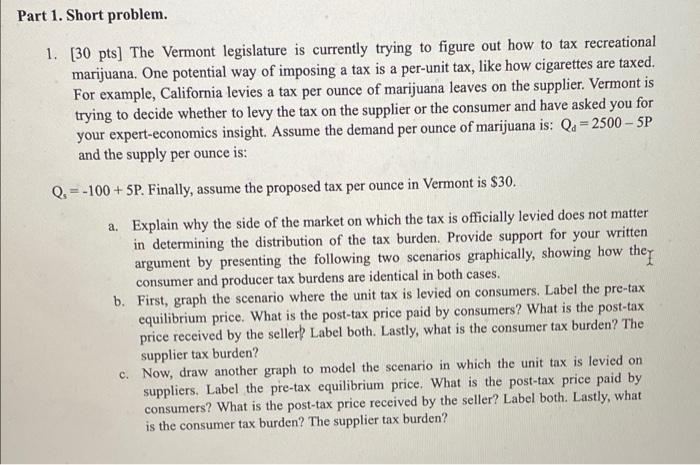Part 1. Short problem. 1. [30 pts] The Vermont legislature is currently trying to figure out how to tax recreational marijuana. One potential way of imposing a tax is a per-unit tax, like how cigarettes are taxed. For example, California levies a tax per ounce of marijuana leaves on the supplier. Vermont is trying to decide whether to levy the tax on the supplier or the consumer and have asked you for your expert-economics insight. Assume the demand per ounce of marijuana is: Qa=2500 - 5P and the supply per ounce is: Q. :=-100+ SP. Finally, assume the proposed tax per ounce in Vermont is $30. a. Explain why the side of the market on which the tax is officially levied does not matter in determining the distribution of the tax burden. Provide support for your written argument by presenting the following two scenarios graphically, showing how they consumer and producer tax burdens are identical in both cases. b. First, graph the scenario where the unit tax is levied on consumers. Label the pre-tax equilibrium price. What is the post-tax price paid by consumers? What is the post-tax price received by the seller Label both. Lastly, what is the consumer tax burden? The supplier tax burden? c. Now, draw another graph to model the scenario in which the unit tax is levied on suppliers. Label the pre-tax equilibrium price. What is the post-tax price paid by consumers? What is the post-tax price received by the seller? Label both. Lastly, what is the consumer tax burden? The supplier tax burden? Part 1. Short problem. 1. [30 pts] The Vermont legislature is currently trying to figure out how to tax recreational marijuana. One potential way of imposing a tax is a per-unit tax, like how cigarettes are taxed. For example, California levies a tax per ounce of marijuana leaves on the supplier. Vermont is trying to decide whether to levy the tax on the supplier or the consumer and have asked you for your expert-economics insight. Assume the demand per ounce of marijuana is: Qa=2500 - 5P and the supply per ounce is: Q. :=-100+ SP. Finally, assume the proposed tax per ounce in Vermont is $30. a. Explain why the side of the market on which the tax is officially levied does not matter in determining the distribution of the tax burden. Provide support for your written argument by presenting the following two scenarios graphically, showing how they consumer and producer tax burdens are identical in both cases. b. First, graph the scenario where the unit tax is levied on consumers. Label the pre-tax equilibrium price. What is the post-tax price paid by consumers? What is the post-tax price received by the seller Label both. Lastly, what is the consumer tax burden? The supplier tax burden? c. Now, draw another graph to model the scenario in which the unit tax is levied on suppliers. Label the pre-tax equilibrium price. What is the post-tax price paid by consumers? What is the post-tax price received by the seller? Label both. Lastly, what is the consumer tax burden? The supplier tax burden







